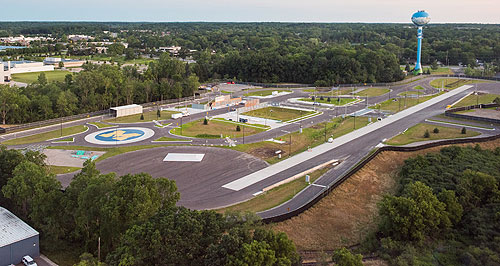News - General News - TechnologyUnique autonomous vehicle centre opens in USCity scape: The Mcity site at the University of Michigan will help researchers determine the future of autonomous motoring. University of Michigan starts operations at dedicated driverless car trial centre28 Jul 2015 By IAN PORTER THE University of Michigan has opened the world’s first centre dedicated to the testing of autonomous and connected vehicles at a purpose-built 13-hectare site outside the city of Ann Arbor. The new trial centre, called Mcity, enhances the University’s position as the leading US research centre into future mobility options, a position built up under the direction of expatriate Australian Peter Sweatman. Built at a cost of $US8 million ($A11 million), the new centre will conduct deep research into driverless and connected cars and, crucially, how the two functions can be made to work together. Speaking at the opening, Dr Sweatman said the transformation to autonomous and connected vehicles would bring big improvements in safety, efficiency, energy usage and accessibility. “Our cities will be much better to live in, our suburbs will be much better to live in,” he said. “These technologies truly open the door to 21st century mobility.” Mcity has been jointly funded by the University ($US5 million) and the Michigan department of transport ($US3 million) so they can better understand what will be required to support future transport systems and to understand how these systems can be incorporated into city life. “The interest with automated vehicles is what does that mean for the infrastructure in cities,” Dr Sweatman told GoAuto when he visited Melbourne in March for the Cars of Tomorrow conference run by the AutoCRC. “Should it be designed differently? Maintained differently? What are the key priorities in the infrastructure, particularly when it comes to maintenance?” he said. The work at Mcity will do more than research into the emerging technologies. The overall aim is to do the groundwork to underpin the installation of an automated mobility public transport service for Ann Arbor citizens. “They will be automated vehicles, probably unconventional automated vehicles,” Dr Sweatman said. “You will call them up on your smartphone, order a ride, the vehicle comes to you, you go somewhere and then the vehicle goes away and does something else. “You won’t own the vehicles, they will be shared. The key characteristics are that they will be automated, or driverless, and shared. Once you put those two things together, then you have a quite different mobility situation.” He said the research program will be aimed at discovering how it is going to work, what people like about it, and what they don’t like about it. “We think that is the kind of thing we will need on a big scale in future.” Dr Sweatman said many believed such an automated system would be ideal for older people who no longer drive their own cars, but he was unsure. “I think a lot of people, on the face of it, see a lot of value in it for the older population, but the reason we need to do these trials is so we can figure out whether that is true, and what complications there might be. “While the older generation might benefit from an automated driverless shuttle that picks them up and drops them off somewhere, it is also a high-technology product and old folks aren’t that good at dealing with high tech. “Are they going to be capable, or interested, in ordering something and dealing with the payment side of it.” The Mcity site comprises normal roads lined with facades of buildings like a film set in order to emulate as closely as possible ordinary suburban roads. Much of the on-road trials will be conducted with golf-buggy style vehicles. At the opening ceremony, Dr Sweatman said Mcity would allow researchers to simulate the environments where connected and automated vehicles will be most challenged. “Even seemingly minor details a vehicle might encounter in urban and suburban settings have been incorporated into Mcity, such as road signs defaced by graffiti and faded lane markings,” he said. The types of technologies that will be tested at the facility include connected technologies – vehicles talking to other vehicles (V2V) or to the infrastructure (V2I) and various levels of automation all the way up to fully autonomous vehicles. Another of Dr Sweatman’s responsibilities is the University of Michigan Transportation Research Institute (UMTRI), which is conducting trials of intelligent transport systems (V2V and V2I) with 3000 vehicles – building to 9000 vehicles – in and around Ann Arbor. A second UMTRI field trial involving 20,000 connected vehicles will be established in South-East Michigan within three years. The third and final stage of the program will be the Ann Arbor autonomous public transport system. The US National Highway Traffic Safety Administration (NHTSA) has described four levels of automation in vehicles, with the first being a vehicle with the ability to control one automatic function, such as cruise control. Level two is when a vehicle has two or more automatic functions which can operate in combination, such as adaptive cruise control or cruise control and lane keeping assist. Level three is a vehicle that can run itself automatically for periods with no driver intervention, but the driver must be able to take back control. Level four is when a vehicle can complete a trip with no driver intervention.  Read more |
Click to shareGeneral News articlesResearch General News Motor industry news |



























Facebook Twitter Instagram